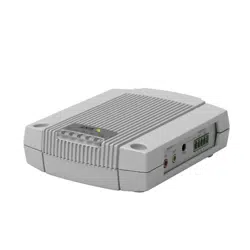Loading ...
Loading ...
Loading ...

37
AXIS P8221 - Troubleshooting
Symptoms, possible causes, and remedial action
Problems setting the IP address
When using ARP/Ping Try the installation again. The IP address must be set within two minutes after power has been
applied. Ensure the Ping length is set to 408. See the Installation Guide.
AXIS P8221 is located on a different
subnet
If the IP address intended for the unit and the IP address of your computer are located on differ-
ent subnets, you will not be able to set the IP address. Contact your network administrator to
obtain an appropriate IP address.
The IP address is being used by another
device
Disconnect the unit from the network. Run the Ping command. (In a Command/DOS window,
type ping and the IP address of the unit).
If you receive: Reply from <IP address>: bytes = 32; time = 10 ms..... - this means that the IP
address may already be in use by another device on your network. You must obtain a new IP
address and reinstall the unit.
If you see: Request timed out - this means that the IP address is available for use with your
unit. In this case, check all cabling and reinstall the unit.
Possible IP address conflict with
another device on the same subnet
The static IP address in the unit is used before the DHCP server sets a a dynamic address. This
means that if the same default static IP address is also used by another device, there may be
problems accessing the unit. To avoid this, set the static IP address to 0.0.0.0.
AXIS P8221 cannot be accessed from a browser
Cannot log in When HTTPS is enabled, ensure that the correct protocol (HTTP or HTTPS) is used when attempt-
ing to log in. You may need to manually type http or https in the browser’s address field.
The IP address has been changed by
DHCP
If the device and client are on the same network, Run AXIS IP Utility to locate the device. Iden-
tify the device using its model or serial number
Alternatively:
1) Move the unit to an isolated network or to one with no DHCP or BOOTP server. Set the IP
address again, using AXIS IP Utility (see the Installation Guide) or the ARP/Ping commands.
2) Access the unit and disable DHCP in the TCP/IP settings. Return the unit to the main network.
The unit now has a fixed IP address that will not change.
Other networking problems Test the network cable by connecting it to another network device, then Ping that device from
your workstation. See instructions above.
AXIS P8221 is accessible locally, but not externally
Broadband router configuration To configure your broadband router to allow incoming data traffic to AXIS P8221, enable the
NAT-traversal feature which will attempt to automatically configure the router to allow access
to the device.
This is enabled from Setup > System Options > Network > TCP/IP Advanced.
Note that the router must support UPnP
TM
.
Firewall protection Check the Internet firewall with your system administrator.
Default routers required Check if you need to configure the default router settings.
Problems with audio streaming
No audio in the client Make sure that AXIS Media Control (AMC) is installed on your workstation.
Check that the correct network interface is selected in the AMC Control Panel (Streaming tab)
Check that the relevant RTSP connection methods are enabled in the AMC Control Panel
(Streaming tab).
No multicast audio in the client Check with your network administrator that the multicast addresses used by the device are valid
for your network.
Check with your network administrator to see if there is a firewall preventing access.
Multicast audio only accessible by local
clients
Check if your router supports multicasting, or if the router settings between the client and the
server need to be configured. The TTL (Time To Live) value may need to be increased.
No audio
Incorrect setup Check the sound card in the PC. Ensure that the mute button is not pressed and the volume set-
tings are correct.
No audio or
very poor audio quality
Check that the correct Audio Input Port (Audio 1 or Audio 2) and Source (Microphone or Line)
are selected under Setup > Audio > Audio Settings.
Audio volume too low/high
Volume settings incorrect The volume of the microphone is either too high or too low. Change the volume for the micro-
phone in the toolbar on the Live View page.
Poor audio quality
CPU overloaded Reduce the number of clients.
Unsynchronized audio and video It is recommended that the device’s time setting is synchronized with an NTP Server. This is
enabled under System Options > Date & Time.
Loading ...
Loading ...
Loading ...
